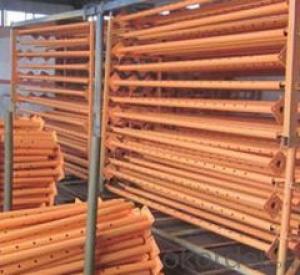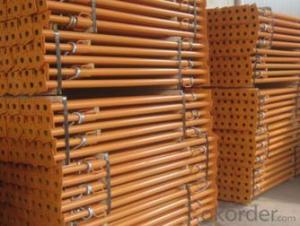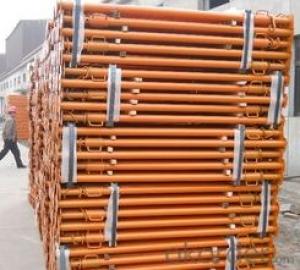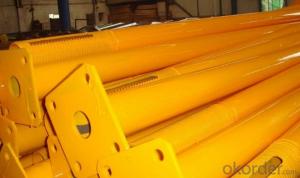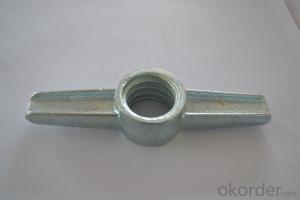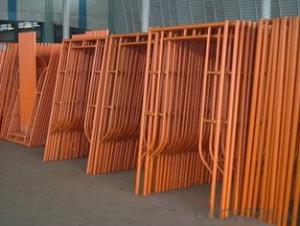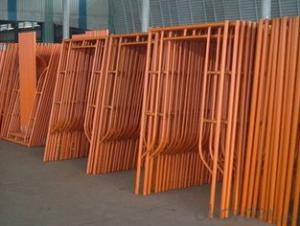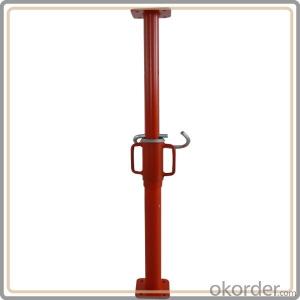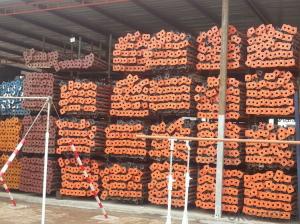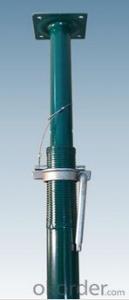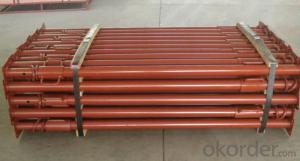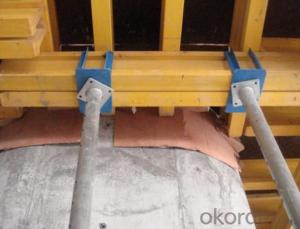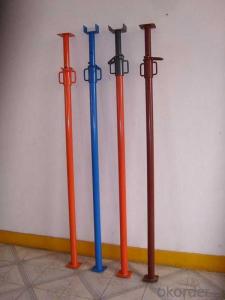heavy duty steel prop for scaffolding
- Loading Port:
- China Main Port
- Payment Terms:
- TT OR LC
- Min Order Qty:
- -
- Supply Capability:
- -
OKorder Service Pledge
OKorder Financial Service
You Might Also Like
| Brand Name: | Model Number: | ||||
| name: | surface: | package: | |||
| port:: | color: | Scaffolding Part Type: | |||
| material: | Certification: |
Packaging & Delivery
| Packaging Detail: | suitable for sea transportation |
| Delivery Detail: | Prompt |
Specifications
1.adjustable scaffolding steel prop
2.Model Size: Different size
3.Surface: Painted ,galvanized
4.Same price,better quality
adjustable scaffolding Steel prop
Scaffolding Adjustable Steel Props
Nut: Normal / Cup,
Size: Tailor mading,
Manufacturer with best price, quality & service!
2.2-3.9M Scaffolding Adjustable Steel Props
we are MANUFACTURER, can produce any size according to your demand.
this is some normal used catalog for props:
1. adjustable length: 0.8-1.4m / 1.6-3.0m / 2.0-3.6m / 2.0-3.5m / 2.2-4.0 m / 3.0-5.5 m
2. inner tube's diameter: 40 mm / 48 mm / 60 mm
3. outer tube's diameter: 48 mm / 56 mm / 76 mm
4. wall thickness: 1.6-4.0 mm
5. surface treatment: painted, e-galvanized, powder coated, hot dip galvanized
any detailed information or any questions, please contact me .
- Q: Can steel props be used for temporary support in tunnels?
- Yes, steel props can be used for temporary support in tunnels. Steel props are commonly used in construction projects to provide temporary support to structures, including tunnels. They are designed to withstand heavy loads and provide stability during construction or maintenance activities. Steel props are adjustable, allowing them to be easily installed and removed as needed. Additionally, they can be customized to fit the specific dimensions and requirements of the tunnel project. Overall, steel props are a reliable and effective solution for providing temporary support in tunnels.
- Q: How do you calculate the required height for a steel prop?
- To calculate the required height for a steel prop, you need to consider the load that the prop will bear. The formula typically used is load divided by safe working load per square meter. This will give you the required height in meters.
- Q: Why subway steel support axial force value
- The main reasons are as follows: 1. The deformation of foundation pit is too large;2, caused by high temperature;Generally, the foundation pit is supported by continuous wall (pile) and steel support. Support axial force monitoring, monitoring the foundation pit in the construction process of the support axial force changes, to avoid the bearing axial force beyond the design strength of the support failure caused by the instability of the whole support system.
- Q: Can steel props be used in mining applications?
- Yes, steel props can be used in mining applications. Steel props are commonly used in mining to provide temporary support to underground structures and excavations. They are designed to withstand high loads and offer stability and safety in mining operations.
- Q: Can steel props be used for bridge construction?
- Yes, steel props can be used for bridge construction. Steel props, also known as adjustable steel props or steel shore, are commonly used in construction projects to support temporary structures such as formwork, scaffolding, or falsework. They provide stability and load-bearing capacity during the construction phase. In bridge construction, steel props can be used to support various components of the bridge. For example, during the erection of bridge girders, steel props can be used to provide temporary support until the girders are properly secured. They can also be used to support formwork for casting bridge decks or other concrete elements. Steel props offer several advantages for bridge construction. Firstly, they are made of steel, which has high strength and durability, making them capable of withstanding heavy loads. Secondly, they are adjustable, allowing for precise height adjustments to accommodate different bridge construction stages and variations in ground levels. This adjustability makes them versatile and suitable for various bridge construction scenarios. Furthermore, steel props are easy to install, disassemble, and transport, making them a convenient choice for temporary support in bridge construction projects. They can be quickly adjusted and reused in different locations, saving time and cost during the construction process. However, it is important to note that steel props are typically used as temporary supports during construction and are not intended to be permanent load-bearing elements of the bridge structure. Once the bridge is completed, the steel props are removed, and the permanent support system takes over the load-bearing function. In conclusion, steel props can be effectively used for bridge construction as temporary supports. They provide stability, load-bearing capacity, and adjustability, making them a reliable choice for supporting various components of the bridge during the construction phase.
- Q: Can steel props be used for temporary support in pipeline construction?
- Steel props can indeed be utilized for temporary support in pipeline construction. It is quite common to employ steel props in construction ventures as they offer temporary support to structures and systems. They possess the ability to be adjusted and tailored to meet specific requirements with ease. When it comes to pipeline construction, steel props can effectively bear the weight of the pipeline while ensuring stability during the installation phase. Moreover, they can be deployed to reinforce specific locations where additional support is necessary. Due to their strength, durability, and impressive load-bearing capacity, steel props are perfectly suited for providing temporary support in pipeline construction.
- Q: How do steel props compare to aluminum props in terms of performance?
- Steel props and aluminum props have different properties and performance characteristics that make them suitable for different applications. Steel props are generally stronger and more durable compared to aluminum props. They can withstand higher loads and are less prone to bending or breaking under heavy use or extreme conditions. On the other hand, aluminum props are lighter and more corrosion-resistant than steel props. This makes them more suitable for applications where weight is a critical factor, such as in aerospace or marine industries. Aluminum props also have better performance in terms of fuel efficiency, as their lighter weight allows for better acceleration and higher top speeds. In summary, steel props are preferred for heavy-duty applications where strength and durability are crucial, while aluminum props are favored for applications that require lightweight and corrosion-resistant materials. The choice between steel and aluminum props ultimately depends on the specific needs and requirements of the application in question.
- Q: How do you calculate the number of steel props needed for a project?
- To calculate the number of steel props needed for a project, several factors need to be considered. 1. Determine the load: Start by calculating the total load that the props will need to support. This includes the weight of the structure or formwork, as well as any additional loads such as equipment, materials, or people. 2. Identify the spacing: Determine the spacing between the props. This depends on the size and shape of the structure, as well as the required support. Generally, props are placed at regular intervals to evenly distribute the load. 3. Consider the prop capacity: Each steel prop has a specific load-bearing capacity, which is typically provided by the manufacturer. Ensure that the props chosen can support the calculated load. 4. Calculate the load per prop: Divide the total load by the number of props to determine the load per prop. This ensures that each prop can safely support its share of the load. 5. Account for safety factors: It is recommended to apply a safety factor to the calculated load to ensure that the props have an additional margin of safety. This accounts for potential variations in load distribution or unforeseen circumstances. 6. Round up: Once the load per prop is determined, round up to the nearest whole number to account for any additional load variations or to ensure sufficient support. 7. Consider additional requirements: Depending on the project, additional factors such as the height of the structure, the type of formwork, or any specific engineering requirements may need to be taken into account. Consult with structural engineers or experienced professionals to ensure accuracy and compliance with building codes and regulations. By considering these factors and following industry standards and guidelines, you can accurately calculate the number of steel props needed for a project, ensuring adequate support and safety.
- Q: Are steel props resistant to ultraviolet (UV) radiation?
- No, steel props are not resistant to ultraviolet (UV) radiation.
- Q: How do steel props compare to hydraulic shoring systems?
- Steel props and hydraulic shoring systems both serve the purpose of providing temporary support to structures during construction or repair work. However, they differ in terms of their mechanisms and capabilities. Steel props are adjustable steel columns that are manually adjusted and secured in place to provide support. On the other hand, hydraulic shoring systems use hydraulic jacks to provide adjustable support. In terms of ease of use, hydraulic shoring systems have an advantage as they can be adjusted quickly and easily with the help of hydraulic pressure, whereas steel props require manual adjustments. Additionally, hydraulic shoring systems offer greater flexibility and precision in adjusting the support height compared to steel props. In terms of load-bearing capacity, both systems can handle significant loads, but hydraulic shoring systems generally have a higher load-bearing capacity due to their hydraulic mechanisms. This makes them suitable for supporting heavier structures. However, it is worth noting that hydraulic shoring systems can be more expensive and require specialized training for proper usage and maintenance. On the other hand, steel props are generally more cost-effective and easier to handle, making them a popular choice for smaller construction projects. Ultimately, the choice between steel props and hydraulic shoring systems depends on the specific requirements of the project, including the load-bearing capacity needed, the ease of use desired, and the budget available.
Send your message to us
heavy duty steel prop for scaffolding
- Loading Port:
- China Main Port
- Payment Terms:
- TT OR LC
- Min Order Qty:
- -
- Supply Capability:
- -
OKorder Service Pledge
OKorder Financial Service
Similar products
Hot products
Hot Searches
Related keywords
